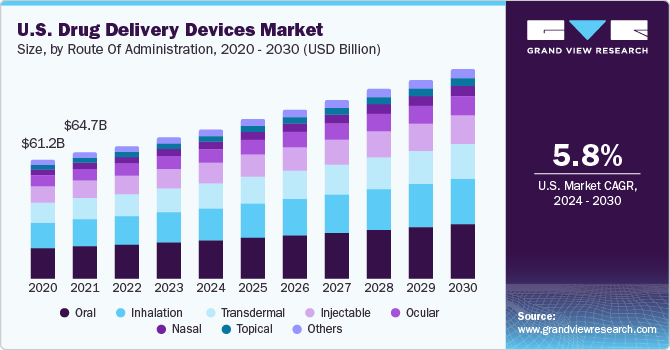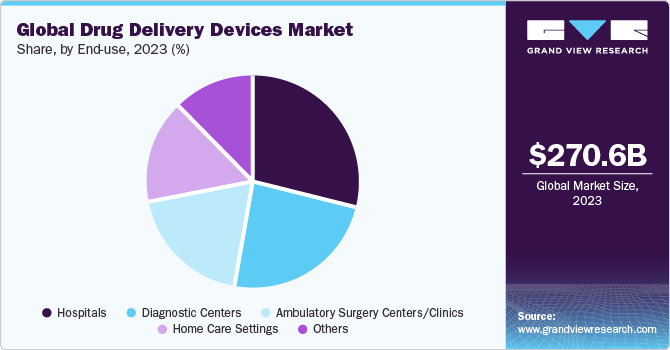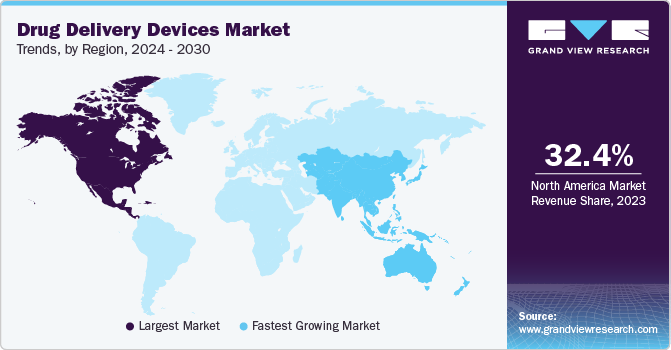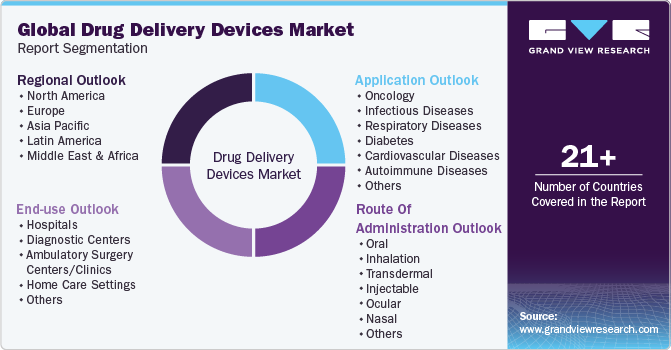- Home
- »
- Medical Devices
- »
-
Drug Delivery Devices Market Size And Share Report, 2030GVR Report cover
![Drug Delivery Devices Market Size, Share & Trends Report]()
Drug Delivery Devices Market Size, Share & Trends Analysis Report By Application (Oncology, Infectious Diseases), By Route Of Administration (Oral, Transdermal, Injectable), By End-use, By Region, And Segment Forecasts, 2024 - 2030
- Report ID: GVR-4-68038-435-2
- Number of Report Pages: 140
- Format: PDF, Horizon Databook
- Historical Range: 2018 - 2022
- Forecast Period: 2024 - 2030
- Industry: Healthcare
Drug Delivery Devices Market Size & Trends
The global drug delivery devices market size was estimated at USD 270.6 billion in 2023 and is anticipated to grow at a compound annual growth rate (CAGR) of 5.83% from 2024 to 2030. Increasing adoption of advanced technology for effectively delivering drugs on the target site is expected to drive the overall market growth. Moreover, usage of these drug delivery devices reduces the chances of side effects by optimizing the delivery of drugs at target site. This helps in minimizing the dose and associated side effects. In addition, this helps in reducing the overall product price by reducing the amount of active pharmaceutical ingredients. Increasing demand for novel drug delivery devices is expected to boost the R&D in the field.

Major market players are continuously engaged in strategic alliances to develop advanced technology for various applications. For instance, in October 2023 Victrex plc, known for its innovative PEEK biomaterial solutioInc.ns, introduced an advanced product, the VICTREX PC101 grade, specifically designed for drug delivery and pharmaceutical contact applications. This launch aligns with the growing trend of utilizing drug delivery devices in home-care environments, enhancing accessibility for patients seeking these innovative solutions.
Pertaining to the demand growth, various companies are developing patient-friendly drug delivery devices and other market players are acquiring these companies to expand their portfolio. In April 2023, DifGen Pharmaceuticals acquired Aveva Drug Deliver Services Inc, strengthening its position in offering intricate pharmaceutical dosage forms. This strategic move not only boosts DifGen's capabilities but also establishes a robust presence in the United States, expanding its development and manufacturing capacities.
Ongoing studies in the healthcare industry include technological advancements in drug delivery devices to make them more patient-friendly, accessible, and accurate. Players in the industry are continuously researching innovative technologies and developing advanced drug delivery devices. For instance, AstraZeneca is developing next-generation technologies to enhance the efficacy and safety profile of drug delivery systems. They are concentrating on improving the patient experience by developing medications that are easier to use, require less frequent doses, and are more convenient. In addition, pharmaceutical industries are continuously seeking the development and application of modern technologies for the advancement and design of modern drug-providing systems. Computational studies have helped envisage molecular interactions of drugs and develop next-generation drug inventions such as target-based drug discovery. By advancing the science of drug delivery, the industry aims to improve the way in which patients experience medicines.
Despite the advantages and advancements associated with these drug supply devices, certain challenges are expected to impede the market growth. The major challenge faced with these drug delivery devices is their inefficiency in delivering poorly soluble medications. Moreover, other bioavailability hurdles of poorly soluble tablets are also expected to impact the market growth. In addition, these drug devices may release uncontrolled drugs on the infection site, which can later lead to other side effects such as infections and allergies.
Route of Administration Insights
Based on route of administration, the market is categorized into oral, inhalation, transdermal, injectable, ocular, nasal, topical, and others segments. The others segment includes routes of administration such as subcutaneous, intradermal, and intravenous. The oral route of administration segment is dominating the market in 2023 with a market share of 26.81%.
The oral drug delivery system includes a wide range of dosage forms including tablets, capsules, syrups, solutions, and suspensions. This segment also includes distribution products such as films and tablets. The oral route is the preferred route of administration in terms of safety, ease of use, cost, and stability. Inhalation drug delivery systems are preferred in cases of pulmonary conditions such as asthma and chronic obstructive pulmonary disease (COPD). Factors such as growing prevalence of respiratory diseases and technological advancement of devices used for inhalation such as nebulizers and inhalers are expected to propel the growth of this segment.
The injectable route of administration is expected to expand at the fastest CAGR over the forecast period. Advancements in injectable drug delivery systems, such as introduction of prefilled syringes and pen injectors, have increased the demand in the past few years. In addition, development of materials for syringes such as polymers, which are inert toward most of the chemicals, is driving the market growth.
Application Insights
Based on application, the market is segmented into oncology, infectious diseases, respiratory diseases, diabetes, cardiovascular diseases, autoimmune diseases, neurology, and others. The others segment includes endocrine disorders and ophthalmic disorders. Drug delivery devices in the field of diabetes segment dominated the market in 2023 with a market share of 21.12%. This is mainly due to increasing prevalence of diabetes. For instance, according to 2022 CDC statistics, there is a significant impact, with 37.3 million individuals in the United States affected, constituting 11.3% of the population. Of these, 28.7 million people have received a diagnosis, encompassing 28.5 million adults, while an additional 8.5 million individuals remain undiagnosed, representing 23.0% of undiagnosed cases among adults.
The oncology segment held a significant share in the market and is anticipated to grow at a moderate CAGR over the forecast period owing to increasing prevalence of cancer globally. In 2022, around 1,918,030 new cancer cases were diagnosed in U.S. Two types of drug delivery systems majorly used in oncology are liposomal and albumin nanoparticle drug delivery devices.
The Central Nervous System (CNS) disorders segment is estimated to grow at a CAGR of 6.65% over the forecast period. Growing incidence of neurological disorders such as Parkinson’s disorder, Alzheimer’s disease, Hunter’s syndrome, and brain tumor is expected to boost the segment growth over the forecast period. Therefore, to enhance the treatment of these neurological disorders, new devices are being developed for CNS based on rational drug design and using receptor-ligand interaction for understanding the appropriateness of drugs delivery on the site.
End-use Insights
Based on end-use, the market is categorized into hospitals, diagnostic centers, ambulatory surgery centers/clinics, home care settings, and others segments. The others segment includes research centers, universities, and institutes. The hospitals segment held the largest market share in 2023 with a share of 29.08%, mainly due to increasing cases of cancer, diabetes, and neurological disorders. Patients admitted to the hospital with various disorders require different drugs for treatment for which various drug delivery devices are used. However, hospital-acquired infection is expected to impact the adoption of drug delivery devices in hospitals, which in turn may decline the segment growth over the forecast period.
Diagnostic centers also held a significant share in the market in 2023. Various diagnostic centers are focusing on developing and adopting novel delivery devices for delivering drugs accurately. Center for Drug Delivery and Nanomedicine (CDDN) is focusing on capturing existing expert knowledge both scientifically and technically in biomedical science research and material for creating Nano medicine programs and interdisciplinary delivery. Moreover, the main mission of the center is to understand the efficiency and safety of various drugs and to develop innovative methods.

The home care settings segment is anticipated to experience the fastest CAGR during the forecast period. Major factors contributing to the growth of this segment are growing hospital-acquired infections, high costs, and longer wait times in hospitals. This, in turn, is increasing the trend of self-administration and hence is resulting in increased treatments in home care settings in comparison to hospitals and other diagnostic centers.
Regional Insights
Based on region, North America held the largest market share of 32.39% in 2023. This can be attributed to the presence of major players in the region and growing adoption of drug supply devices. Moreover, increasing awareness in the region regarding the advantages of drug delivery devices is also expected to boost the market growth in the region. In addition, growing product approval in countries such as U.S. is also expected to contribute toward the market growth. In June 2023, Stevanato Group has launched Vertiva, a customizable platform for drug distribution, which is suitable for a wide range of therapies and large approach volumes.

Europe region held a significant share in 2023 and is expected to grow at a moderate CAGR. Developed economies and favorable regulatory procedures are some of the principal factors providing huge opportunities for the major market players in the region. Asia Pacific is expected to experience the fastest growth rate during the forecast period owing to high economic growth in the region. Moreover, a large patient pool in countries such as Japan, China, and India is also leading to adoption of drug supply devices by various end-users. In addition, in Japan, diverse types of drug delivery devices are in use for delivering specific type of drugs.
Key Companies & Market Share Insights
The development of new products, product modifications, and major investments in R&D are among the key strategies adopted by market players to gain a competitive edge. For instance, in October 2023, Enable Injections received FDA approval for their EMPAVELI Injector, an innovative on-body subcutaneous drug delivery system designed for large volumes. This marks a major achievement in the field of drug delivery technology.
Key Drug Delivery Devices Companies:
- Pfizer, Inc.
- Johnson & Johnson Services, Inc.
- F. Hoffmann-La Roche, Ltd.
- Novartis AG
- BD
- Bayer AG
- uniQure N.V.
- Sibiono GeneTech Co. Ltd.
Drug Delivery Devices Market Report Scope
Report Attribute
Details
Market size value in 2024
USD 287.2 billion
Revenue forecast in 2030
USD 403.6 billion
Growth rate
CAGR of 5.83% from 2024 to 2030
Base year for estimation
2023
Historical data
2018 - 2022
Forecast period
2024 - 2030
Quantitative units
Volume in units, revenue in USD million/billion, and CAGR from 2023 to 2030
Report coverage
Volume & revenue forecast, company ranking, competitive landscape, growth factors, and trends
Segments covered
Application, route of administration, end-use, region
Regional scope
North America; Europe; Asia Pacific; Latin America; Middle East & Africa
Country scope
U.S.; Canada; UK; Germany; France; Italy; Spain; Denmark; Sweden; Norway; China; India; Japan; Australia; Thailand; South Korea; Brazil; Mexico; Argentina; South Africa; Saudi Arabia; UAE; Kuwait
Key companies profiled
Pfizer, Inc.; Johnson & Johnson Services, Inc.; F. Hoffmann-La Roche, Ltd.; Novartis AG; BD; Bayer AG; uniQure N.V.; Sibiono GeneTech Co. Ltd
Customization scope
Free report customization (equivalent up to 8 analyst’s working days) with purchase. Addition or alteration to country, regional & segment scope.
Pricing and purchase options
Avail customized purchase options to meet your exact research needs. Explore purchase options.
Global Drug Delivery Devices Market Report Segmentation
This report forecasts revenue and volume growth at global, regional, and country levels and provides an analysis on the latest industry trends in each of the sub-segments from 2018 to 2030. For this study, Grand View Research has segmented the global drug delivery devices market report based on route of administration, application, end-use, and region:

-
Route of Administration Outlook (Volume, Units; Revenue, USD Billion, 2018 - 2030)
-
Oral
-
Inhalation
-
Transdermal
-
Injectable
-
Ocular
-
Nasal
-
Topical
-
Others
-
-
Application Outlook (Volume, Units; Revenue, USD Billion, 2018 - 2030)
-
Oncology
-
Infectious Diseases
-
Respiratory Diseases
-
Diabetes
-
Cardiovascular Diseases
-
Autoimmune Diseases
-
Central Nervous System Disorders
-
Others
-
-
End-use Outlook (Volume, Units; Revenue, USD Billion, 2018 - 2030)
-
Hospitals
-
Diagnostic Centers
-
Ambulatory Surgery Centers/Clinics
-
Home Care Settings
-
Others
-
-
Regional Outlook (Volume, Units; Revenue, USD Billion, 2018 - 2030)
-
North America
-
U.S.
-
Canada
-
-
Europe
-
Germany
-
UK
-
France
-
Italy
-
Spain
-
Denmark
-
Sweden
-
Norway
-
-
Asia Pacific
-
China
-
Japan
-
India
-
Australia
-
South Korea
-
Thailand
-
-
Latin America
-
Brazil
-
Mexico
-
Argentina
-
-
Middle East & Africa
-
South Africa
-
Saudi Arabia
-
UAE
-
Kuwait
-
-
Frequently Asked Questions About This Report
b. The global drug delivery devices market size was estimated at USD 270.6 billion in 2023 and is expected to reach USD 287.2 billion in 2024.
b. The global drug delivery devices market is expected to grow at a compound annual growth rate of 5.83% from 2024 to 2030 to reach USD 403.6 billion by 2030.
b. North America dominated the drug delivery devices market with a share of 32.39% in 2023. This is attributable to the presence of major market players in the region and the growing trend towards targeted drug delivery systems.
b. Some key players operating in the drug delivery devices market include Pfizer, Inc, Johnson & Johnson Services, Inc., F. Hoffmann-La Roche, Ltd, Novartis AG, BD, Bayer AG, uniQure N.V., Sibiono GeneTech Co. Ltd., Shanghai Sunway Biotech Co., Ltd, and Human Stem Cells Institute.
b. Key factors that are driving the market growth include the increasing prevalence of chronic disorders, growing importance to develop a patient complaint drug delivery system, and the increasing R&D expenditure related to drug delivery device by pharma companies.
Share this report with your colleague or friend.
![gvr icn]()
NEED A CUSTOM REPORT?
We can customize every report - free of charge - including purchasing stand-alone sections or country-level reports, as well as offer affordable discounts for start-ups & universities. Contact us now
![Certified Icon]()
We are GDPR and CCPA compliant! Your transaction & personal information is safe and secure. For more details, please read our privacy policy.
We are committed towards customer satisfaction, and quality service.
"The quality of research they have done for us has been excellent."





